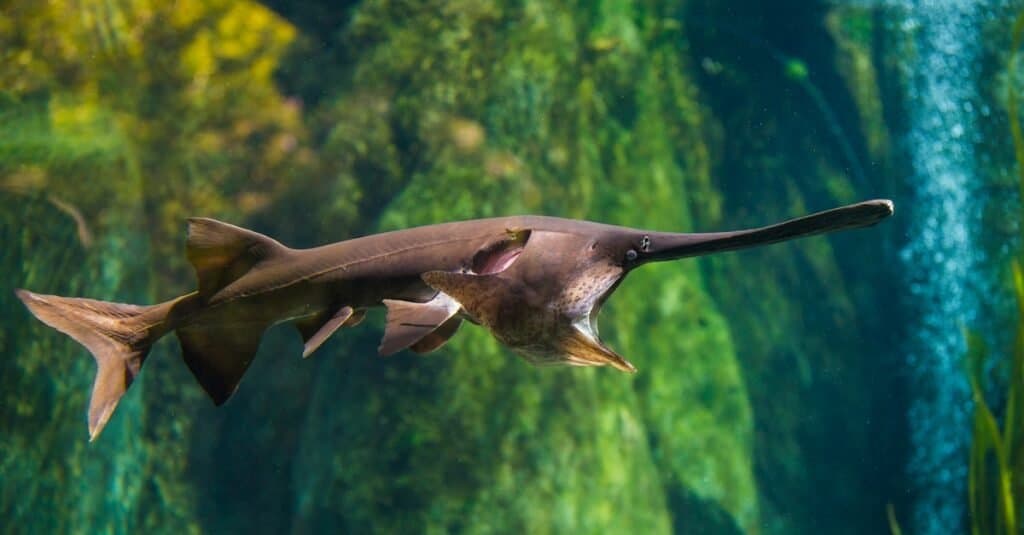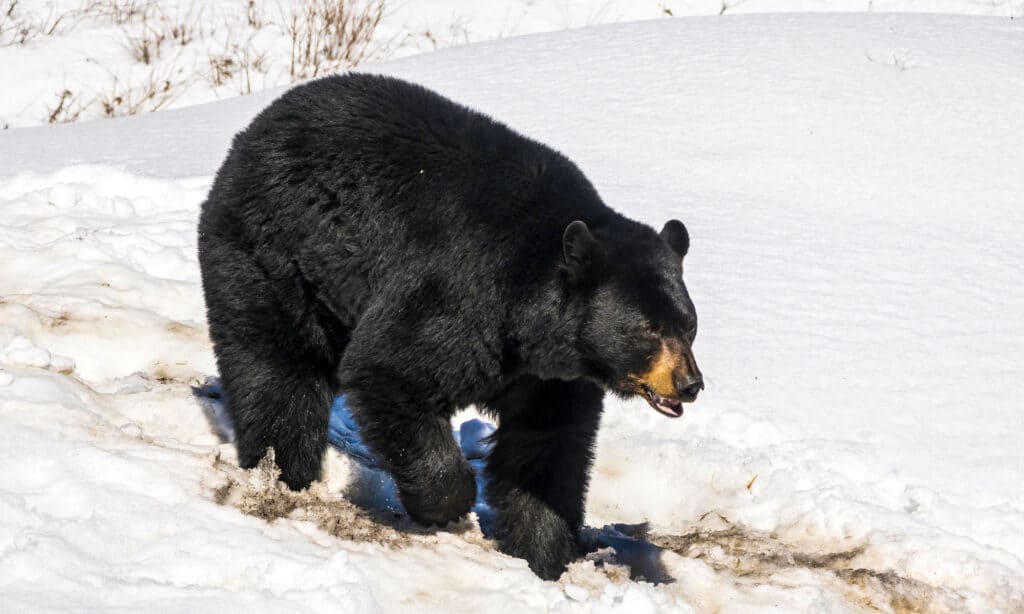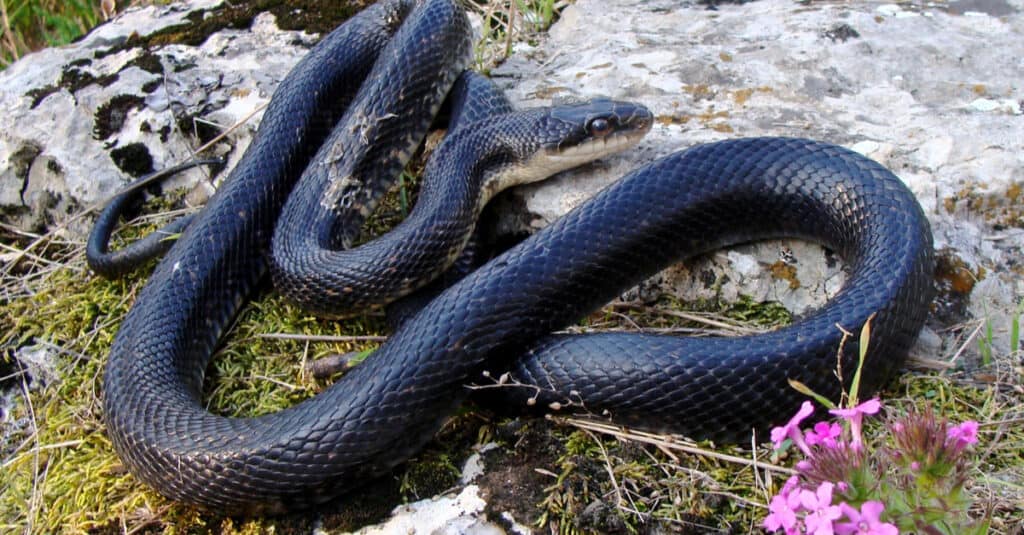West Virginia is home to some extremely vast wildlife, including shrews, bats, skunks, squirrels, white-tailed deer, bobcats, bears, coyotes, and pumas. Virginia also has many salamanders, frogs, toads, and mudpuppies. Snakes include the northern copperhead, eastern cottonmouth, and timber rattlesnake. Virginia’s beautiful lakes are great for fishing and have bass, perch, pike, and trout. Although Virginia’s fauna is diverse, today, we will focus on the largest animals in West Virginia. Let’s kick things off with West Virginia’s largest fish!

1. Largest Fish: American Paddlefish

The American paddlefish is smooth-skinned and almost entirely comprised of cartilage.
©Saran Jantraurai/Shutterstock.com
West Virginia’s largest fish is the 5-foot-long American paddlefish. Paddlefish, formerly thought extinct in West Virginia, live in the Mississippi River Basin. Paddlefish are easily recognizable by their enormous, shark-like rostrums. They’re big, scaleless fish with small eyes and a lengthy opercle flap. Paddlefish have cartilage skeletons. These large fish live for more than 30 years. West Virginia has banned fishing for paddlefish due to conservation concerns. The West Virginia DNR is stocking and studying populations of these important river fish. American paddlefish can weigh 60 pounds and grow to 5 feet. In 1916, Okoboji Lake, IA, had the largest paddlefish caught in the U.S. The speared fish was 7 feet long and 45.5 inches wide.
2. Largest Bird: Northern Goshawk

Male northern goshawks are 18 to 24 inches long and 35 to 41 inches wide.
©Milan Zygmunt/Shutterstock.com
Northern goshawks are rare and hard to find since they live in deep woodlands. However, they do exist in Oklahoma, and the largest and heaviest accipiter hawks are forest hawks. They have long tails and broad, rounded wings. Goshawks have dark heads, backs, and underparts. The name “goshawk” comes from Old English, meaning “goose hawk.” These hawks are called cook’s hawks because they steal meat from farms and cook.
Males are eight percent smaller than females in North American regions. Male northern goshawks are 18 to 24 inches long and 35 to 41 inches wingspan. Females are 23 to 27 inches long and have a 43 to 50-inch wingspan. Males from six subspecies average 1.680 pounds; all races range from 0.8 to 2.6 pounds. Females average 2.54 pounds. The wing chord ranges from 12.8 to 15.4 inches for females and 11.3 to 13.9 inches for males. The culmen measures 0.79 to 1.04 inches, the tail 7.9-11.6 inches, and the tarsus 2.7-3.5 inches.
3. Largest Mammal: Black Bear

The black bear is West Virginia’s official state animal and its largest mammal.
©Josef Pittner/Shutterstock.com
In West Virginia, the black bear is the official state bear and also the state’s largest mammal. The black bear population in West Virginia is currently thought to be statewide. Many of these bears have recently been killed in more than 46 of the 55 counties throughout the state.
Age, sex, health, and season all affect an American black bear’s overall size. For example, in the fall, they tend to weigh 30% more than in the spring. This is when bears come out of their dens. Male adults typically weigh 126–551 pounds, but females average 90–375 pounds.
4. Largest Snake: Black Rat Snake

Reaching a length of up to 8 feet, black rat snakes are among the longest snakes in North America.
©Matt Jeppson/Shutterstock.com
The black rat snake is one of the state’s most common reptiles. It is also the largest snake in the area. Adults normally reach a length of 4 to 6 feet, but researchers have seen specimens of 8 feet. Instead of having a round cross-section, a rat snake’s body is more like a bread loaf. The dorsal scales are hardly keeled, in contrast to the smooth lateral ones. Homes, sheds, meadows, brushlands, woods, and streams are just some places you could see a black rat snake. Mice and other small mammals, as well as birds and their eggs, are among their favorite meals.
5. Largest Insect: Hercules Beetle

Eastern Hercules beetles are among the biggest and heaviest beetles in the United States.
©feathercollector/Shutterstock.com
The eastern Hercules beetle, or Dynastes tityus, is a type of rhinoceros beetle found in the eastern United States, including West Virginia. The elytra of an adult animal are shady gray, green, or tan with black patterns, and the male’s horns can reach a length of 2.4 inches. The length of a male is between 1.6 and 2.4 inches, and he has two horns: one on his thorax, or pronotal horn, and one on his head that sticks outward. For this reason, eastern Hercules beetles are among the biggest and heaviest beetles in the United States. Despite their intimidating appearance, eastern Hercules beetles pose little threat to human beings.
Summary of the 5 Largest Animals in West Virginia, and Where You’ll Find Them
Here’s a recap of the five biggest animals found in West Virginia that we took a look at.
| Number | Animal | Category | Size |
|---|---|---|---|
| 1 | American Paddlefish | Largest Fish | Can grow to 5 feet and weigh 60 pounds |
| 2 | Northern Goshawk | Largest Bird | Males: 18-24 inches long, wingspan of 35 to 41 inches, and average 1.680 pounds; females: 23-27 inches long, wingspan of 43 to 50 inches, and average 2.54 pounds |
| 3 | Black Bear | Largest Mammal | Males weigh 126–551 pounds; females are 90–375 pounds |
| 4 | Black Rat Snake | Largest Snake | Typically 4-6 feet long |
| 5 | Hercules Beetle | Largest Insect | 1.6-2.4 inches long |
The photo featured at the top of this post is © Henk Bogaard/Shutterstock.com
Sources
- Wikipedia, Available here: https://en.wikipedia.org/wiki/List_of_mammals_of_West_Virginia
- West Virginia DNR, Available here: https://wvdnr.gov/plants-animals/
Thank you for reading! Have some feedback for us? Contact the AZ Animals editorial team.






